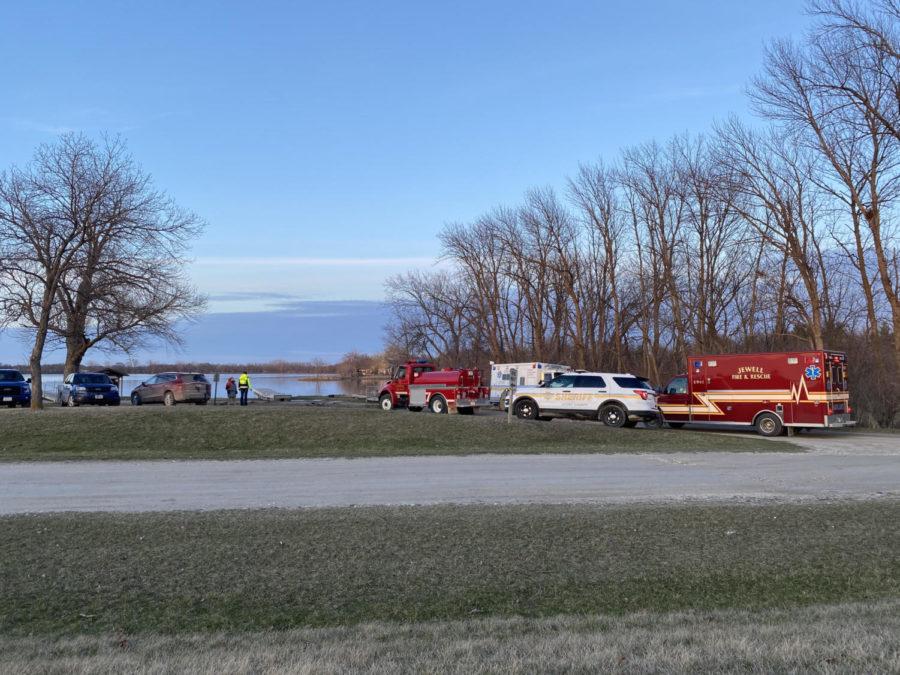Crew club activities suspended following reviews conducted after accident
A search and rescue took place at Little Wall Lake in Hamilton County, where an Iowa State Crew Club boat capsized March 28. Three students were rescued, and two students died.
September 14, 2021
Monday evening, Iowa State University released a preliminary summary detailing two reviews that took place following the Iowa State Crew Club boating accident March 28.
One of the reviews of the accident, which killed students Derek Nanni and Yaakov Ben-David, was an independent external review conducted by the U.S. Council for Athletes Health (USCAH) and Mark Wilson, cofounder of All American Rowing Camp and rowing expert as identified by USRowing.
The other review was an internal review conducted by a committee of university personnel with expertise in student activities and student organizations from different offices across the university, including the Office of University Counsel, the Office of Risk Management, the Student Activities Center and the Department of Public Safety Transportation Services.
The summary noted that the two reviews identified similar concerns and also proposed similar recommendations.
According to the reviews, “the university’s implementation of health and safety policies for university sports clubs was deficient.” This led to an “inadequate” level of oversight for health and safety as well as training and support for the club and other high-risk sports clubs.
According to the reports, clubs, whether they are lower-risk or higher-risk, are all afforded the same level of autonomy, resulting in an incomplete analysis of risks and safety precautions for each club and inadequate policies for higher-risk clubs.
The university also did not clearly define roles and responsibilities for sufficient oversight of sports clubs, resulting in inadequate health and safety oversight and supervision.
While clubs are required to have a faculty/staff adviser, that individual is not clearly empowered, under the current policy, to provide administrative direction or make safety decisions. There is also no clear oversight or accountability to Recreation Services for specific safety and risk management practices as they relate to club events or practices.
“This lack of clarity in the administrative roles and administrative relationship with the Crew Club created an atmosphere where safety issues did not rise to an appropriate level of concern, coordination and oversight by university administration, Recreation Services and the club itself,” the summary read.
“Even where safety concerns were known by Crew Club student leadership and relayed to Recreation Services, neither the club leadership nor Recreation Services took adequate measures to address the safety concerns or suspend club activities until the safety concerns were addressed,” it continued.
Finally, the reviews also found that club leadership failed to follow “critical” health and safety procedures outlined within its constitution. Multiple standards were not applied on the day of the accident, including:
- Wind speeds were acknowledged to be outside of the club’s limits, but practice was not cancelled.
- Club leadership did not adequately respond to changing weather conditions.
- The club had no member or coach available to relay changing conditions or respond to an emergency.
- Two of the team members did not have sufficient experience relevant to present weather and water conditions.
- Club leadership did not have proper safety equipment or communication devices available in event of an emergency.
The university will take immediate actions to address these concerns and better the sports club program on the whole.
Crew Club activities will be suspended for the academic year to allow for health and safety standard implementation.
University Risk Management, Recreation Services and the Student Activities Center will develop a plan for reorganizing the sports club category of student organizations, including:
- Assessing the risk of each club as “high,” “moderate” or “low.”
- Creating a plan that will implement additional mandatory safety training and accountability system for clubs designated as “high” or “moderate” risk.
- Creating a plan to implement policy revisions that will clearly define roles of advisers and Recreation Services and Risk Management administrators regarding health and safety.
This plan should analyze all recommendations proposed by both reviews and should recommend necessary changes to identify those concerns.
A report detailing all of these changes should be completed by Jan. 31, 2022. Implementation of the changes should be completed by the end of the spring semester.
The full reports will be released after appropriate student privacy measures have been applied.







